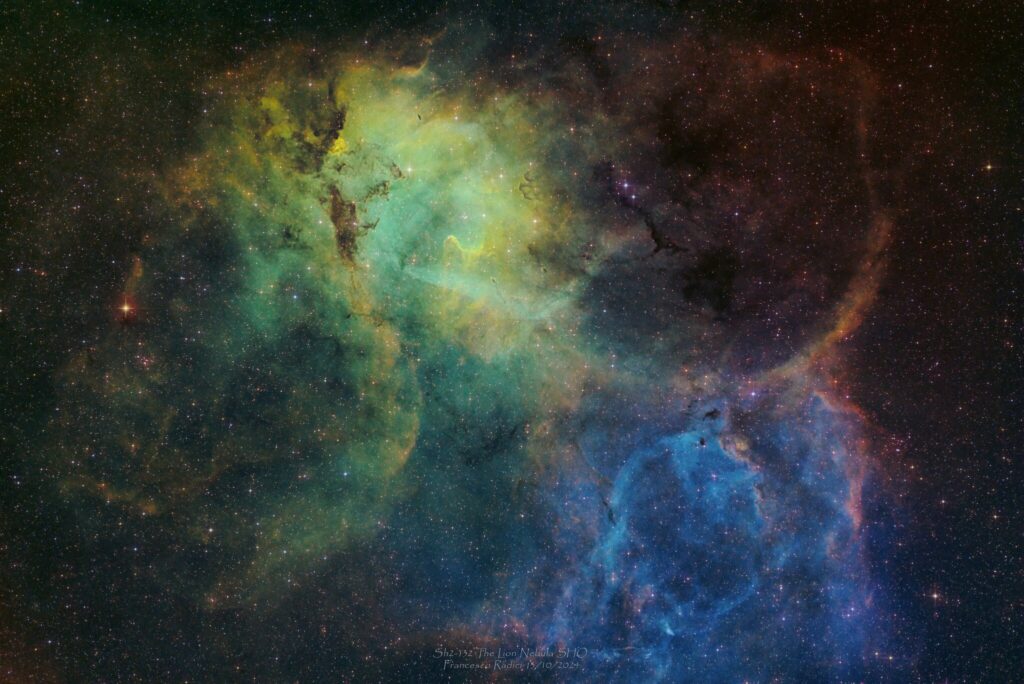
Location of Lion Nebula:
The Sh2-132, more known as the Lion Nebula is located in the constellation Cepheus, approximately 10,000-12,000 light-years away from Earth, in the Perseus Arm of the Milky Way galaxy.
Its celestial coordinates are:
- Right Ascension: 22h 16m
- Declination: +56° 55′
Structure:
Ionized Gas Regions (HII Regions)
- Sh2-132 is classified as an HII region, meaning it’s a large cloud of gas (primarily hydrogen) ionized by the radiation from massive stars. The ultraviolet light from these stars strips electrons from hydrogen atoms, causing the gas to emit light, primarily in the red part of the spectrum (Hydrogen-alpha).
- This ionized hydrogen gives the nebula its main glow, creating a diffuse, ethereal “body” around its core.
Wolf-Rayet Stars and Stellar Winds
- Sh2-132 contains two prominent Wolf-Rayet stars, WR 153 and WR 154. These are massive, evolved stars that emit powerful stellar winds, which sculpt the surrounding gas. Wolf-Rayet stars are known for their intense radiation and mass loss, which create shock waves that push gas and dust outward, forming intricate shapes in the nebula.
- The interaction between these stellar winds and the gas creates cavities, bubbles, and filamentary structures within the nebula.
Filamentary and Knotted Structures
- The Lion Nebula is characterized by complex filaments and knots of gas. These structures are the result of turbulent interactions between the stellar winds, magnetic fields, and the nebula’s own gas, creating denser regions with distinctive textures.
- These filaments are often highlighted in HSO imaging, with different colors representing various gases, adding depth and detail to the nebula’s appearance.
Bright Core and Outer Shells
- The core of the nebula, where the brightest stars are located, is more densely illuminated, surrounded by a fainter, extended shell of ionized gas. This inner region appears brighter in Oxygen (OIII) filters, showing up as greenish-blue, while the outer shells are generally dominated by red tones from Hydrogen-alpha and Sulfur II emissions.
- The central region often appears condensed and compact, while the outer shells form the more diffuse “mane” structure, resembling a lion’s head.
Bubbles and Shock Fronts
- The nebula also contains shock fronts, where gas collides and compresses due to the effects of stellar winds. These fronts create bubble-like structures and arcs, which are visible in narrowband imaging. They often appear as glowing edges around cavities, adding to the nebula’s three-dimensional appearance.
Dark Dust Lanes and Pockets
- Within Sh2-132, there are regions of darker, cooler dust that absorb light, creating shadowed areas and adding contrast to the nebula’s overall shape. These dust lanes appear as dark patches against the glowing background and add to the “lion-like” visual impression
Importance:
The Sh2-132 Lion Nebula holds significant astrophysical importance for a variety of reasons. Here are some of the key aspects that make it an intriguing object of study:
Stellar Evolution and Wolf-Rayet Stars
- Sh2-132 contains Wolf-Rayet stars, which are massive, evolved stars in a late stage of stellar evolution. Wolf-Rayet stars are known for their intense stellar winds and high levels of mass loss. These stars represent a critical phase in the life of massive stars before they end their lives in supernova explosions, enriching the surrounding space with heavy elements.
- Studying these stars within Sh2-132 provides insights into how massive stars evolve, lose mass, and influence their environments. The dynamics of Wolf-Rayet stars contribute to our understanding of the processes leading to supernovae and the seeding of the interstellar medium with elements crucial for forming planets and potentially life.
Star Formation and HII Regions
- As an HII region, Sh2-132 is a site of active star formation. The radiation from young, massive stars ionizes the surrounding hydrogen gas, causing it to glow and marking the nebula as a “stellar nursery.”
- Observing the interactions between these young stars and the nebular gas helps astronomers understand the conditions that lead to star formation, particularly within regions influenced by massive stars. This is essential for building models of how stars form in galaxies and how stellar feedback affects subsequent generations of star formation.
Understanding Stellar Feedback Mechanisms
- The powerful radiation and stellar winds from massive stars within Sh2-132 drive stellar feedback—the process by which stars return energy to their surroundings. This feedback can compress gas to form new stars or disperse gas, suppressing future star formation.
- Studying Sh2-132 gives insight into how stellar feedback operates in nebulae. The complex structures, like bubbles and shock fronts, are direct results of these interactions, helping astronomers refine models of how feedback shapes star-forming regions.
Galactic Chemical Enrichment
- Sh2-132 is part of the larger process of chemical enrichment within the galaxy. As stars within the nebula evolve and eventually explode as supernovae, they release heavy elements like carbon, oxygen, and nitrogen into the interstellar medium.
- This enrichment process is essential for the formation of rocky planets and organic molecules, making Sh2-132 a valuable site for studying how galaxies are chemically enriched over time.
Expanding Knowledge of Nebular Structures
- The nebula’s intricate structure, including its filaments, bubbles, and shock fronts, makes it an excellent example of the complex morphology that can develop in HII regions. Observing these features in detail helps refine theories about how massive stars shape and structure their environments.
- The detailed imaging of these structures, especially in HSO narrowband, allows researchers to map the distribution of elements and assess the physical conditions (like temperature and density) within different parts of the nebula. This mapping is crucial for understanding how such structures form and evolve.
Aesthetic and Educational Value
Additionally, Sh2-132 provides a concrete example of stellar life cycles, helping educators explain processes like stellar birth, evolution, and death to students and astronomy enthusiasts.
The Sh2-132 Lion Nebula is visually stunning, especially in narrowband imaging, making it a popular target for astrophotographers and a great tool for public education. Its striking resemblance to a lion and vibrant colors capture the public’s imagination and can help inspire interest in astronomy and science.
Visual Impact:
I think we can all agree that it’s a beautiful nebula, specially due to its bright colors, as we can see in the image. These colors are caused by powerful stellar winds.
The Lion Nebula receives its name, because it resembles the head of a lion.
In HSO imaging, Sh2-132 often appears vibrant and dynamic, with deep contrasts between the red hues of hydrogen and sulfur and the cooler, greenish-blue areas of oxygen. This combination brings out its “lion-like” features, with wavy mane-like structures framing a more condensed “face” of brighter stars and gas.Sh2-132 is a relatively faint object, so it’s not typically visible with small telescopes. However, long-exposure imaging with the HSO filter setup can reveal its intricate and ethereal details, making it a favorite target for astrophotographers.
Credit:
This image has been taken by Francesco Radici, you can find his image repository here.
